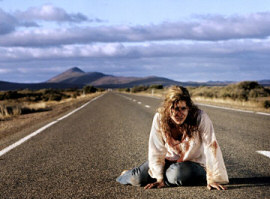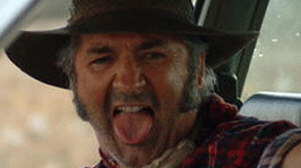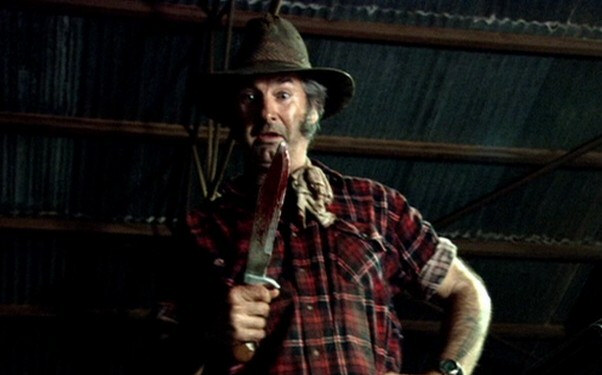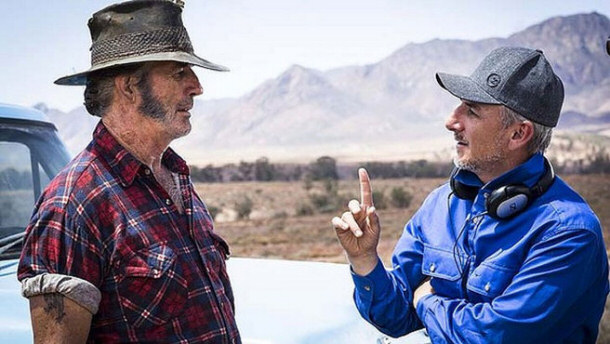The Movie Wolf Creek is an Example of Great Script Analysis & Performance
|
Scene from the movie Wolf Creek:

|
Film making is a process that involves and relies upon numerous elements that
need to be heavily considered so that when they come to together they
collectively achieve the unified goal of producing a successful feature film.
Script analysis and performance are two such crucial elements, that a director
must thoroughly consider and carefully implement both before and during the
production of a film and television project. For this article, I’ll analyze
the directional choices made in relation to the performance approach, casting,
production design and visual language of the film Wolf Creek (2005) to
illustrate the importance of script analysis and performance in the film and
television industries.
to
illustrate the importance of script analysis and performance in the film and
television industries.
The film tells the story of three young backpackers, traveling across the
Australian outback, who get stranded and fall victim to a serial killer. The
directorial decision for the film performance genre is straight horror. With
this in mind, the actors playing the three backpackers subscribed to the Misner
school of acting, which involves living truthfully under their imaginary
circumstances. By far, the most interesting performance approach for the film is
from the film’s villain, Mick Taylor, portrayed by John Jarret.

While Jarret usually subscribes to and applies the Strausberg school of
acting in regards to method acting, he found he could not approach this
particular role from the same angle. Upon reading the script and signing onto
the project, he refused to hear or read any notes about the character as he
didn’t want to know anything about the character of Taylor other than what was
written in the script.
Ultimately, this led Jarret to forget about doing any research for the part
and essentially just mentally write the prequel to the film in his mind that
explained (if only to himself) just why the character thought, felt and reacted
as he did in each and every scene.
|
Mick Taylor:

|
Casting just the right person in the role of Mick Taylor was another integral
element of the film. As the three backpackers in the film are pretty much
stereotypes – young, naive, innocent youths – which was clearly a creative
choice that would allow the audience to identify with them on a emotional level
and empathize with their fear and desperation, the roles of the backpackers were
pretty much interchangeable with any other young actors.
The casting of Mick Taylor, however, was integral to the film’s success.
While the character could easily have fallen into a clichéd Freddy Krueger-type
character, Taylor was never intended to be a bogeyman, but instead, a realistic
monster. The casting of John Jarret in the role was the perfect choice, as it’s
hard to imagine anyone other than Jarret portraying Mick Taylor. In fact, given
how terrifyingly real Jarret’s performance was, one is reminded of something
that Malcolm McDowell who once said of his casting and performance of Alex in ‘A
Clockwork Orange’ (1971) – that while there are hundreds of roles an actor with
play throughout their career, he believes that there will be three roles that
they (and only they) will be BORN to play. If that’s indeed true that John
Jarret as Mick Taylor is one of his three.
Production design was another element of the film that was integral,
particularly in regards to bringing Mick Taylor to life and establishing him as
a realistic monster. Despite drawing inspiration from classic Australian
exploitation films from the 70s and 80s that were full of horror movie clichés,
McLean was clever about the decisions he made in regards to the film’s
production design.

While there was always the risk of going over the top with the production
design, particularly in regards to Mick Taylor’s home – with overly elaborate
torture devises, satanic imagery etc. – production design was kept basic.
Ultimately, this rang true to the character of Mick Taylor and his realistic
evil, whose ominous possessions and look would be downplayed in real-life not
ostentatiously accentuated.
McLean’s creative decision, coupled with the cinematography of Will Gibson,
to utilize the Australian outback as a character was another clever decision and
great use of visual language, as he juxtaposed the visually beautiful with its
ominous and unforgiving capabilities regarding life and death, which is also
reflected in the characters of the film, as a constant theme throughout the
film.

With the numerous directorial decisions to be made and the multitude of
options to choose from, the options that a director ultimately decides upon for
their film are integral. One bad choice regarding performance approach, casting,
production design and visual language can be fatal to a film’s success. Given
the careful consideration that first time director Greg McLean took in regards
to such elements of Wolf Creek it was time well spent.
Television
Top Lists:
15 Astonishing Ways Television Series Make You Sharper
Shorter Top Lists:
10 Actors Who Prove Smart People Make the Best Dumb Characters
8 Lovable Villains from Film and Television
Informational:
The Movie Wolf Creek is an Example of Great Script Analysis & Performance
|